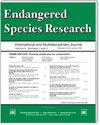Resource use by Sphyrna mokarran and S. lewini (Chondrichthyes) neonates and juveniles in the western Arabian Gulf: a stable isotope analysis
IF 2.9
2区 环境科学与生态学
Q2 BIODIVERSITY CONSERVATION
引用次数: 0
Abstract
ABSTRACT: The great hammerhead shark Sphyrna mokarran and the scalloped hammerhead shark S. lewini are marine top predators with global distributions. However, limited information is available on the trophic ecology of hammerhead sharks in the Indian Ocean. In this study, we measured stable nitrogen and carbon isotopes in the muscle tissues of neonates and juveniles of S. mokarran and S. lewini from the waters of the western Arabian Gulf. In general, values of δ15N were lower in S. mokarran (10.8-18.7‰) than in S. lewini (12.2-18.7‰), indicating a reliance on food sources with low nitrogen values. Isotopic niche similarities were observed between female and male S. mokarran. We further observed considerable ontogenetic changes in the δ15N values of both S. mokarran and S. lewini neonates (a reduction from 19 to 12‰), reflecting the maternal effect. The effects of total length and sex on the nitrogen and stable isotope values were nonsignificant in S. mokarran juveniles. The western Arabian Gulf likely serves as a key feeding ground for both the neonates and the juveniles of S. mokarran. By contrast, S. lewini appears to have a low level of reliance on this region.阿拉伯湾西部 Sphyrna mokarran 和 S. lewini(软骨鱼类)新生儿和幼鱼对资源的利用:稳定同位素分析
摘要:大双髻鲨(Sphyrna mokarran)和扇髻鲨(S. lewini)是分布于全球的海洋顶级掠食者。然而,有关印度洋双髻鲨营养生态学的信息非常有限。在这项研究中,我们测量了来自阿拉伯湾西部水域的 S. mokarran 和 S. lewini 新生和幼鱼肌肉组织中的稳定氮和碳同位素。一般来说,S. mokarran的δ15N值(10.8-18.7‰)低于S. lewini的δ15N值(12.2-18.7‰),表明其对低氮食物来源的依赖。雌性和雄性 S. mokarran 的同位素生态位相似。我们进一步观察到,S. mokarran和S. lewini新生幼体的δ15N值在发育过程中发生了很大变化(从19‰降至12‰),这反映了母体效应。在 S. mokarran 幼体中,总长度和性别对氮和稳定同位素值的影响不显著。阿拉伯湾西部可能是S. mokarran新生幼体的主要觅食地。相比之下,S. lewini 似乎对这一地区的依赖程度较低。
本文章由计算机程序翻译,如有差异,请以英文原文为准。
求助全文
约1分钟内获得全文
求助全文
来源期刊

Endangered Species Research
BIODIVERSITY CONSERVATION-
CiteScore
5.50
自引率
6.50%
发文量
38
审稿时长
31 weeks
期刊介绍:
ESR is international and interdisciplinary. It covers all endangered forms of life on Earth, the threats faced by species and their habitats and the necessary steps that must be undertaken to ensure their conservation. ESR publishes high quality contributions reporting research on all species (and habitats) of conservation concern, whether they be classified as Near Threatened or Threatened (Endangered or Vulnerable) by the International Union for the Conservation of Nature and Natural Resources (IUCN) or highlighted as part of national or regional conservation strategies. Submissions on all aspects of conservation science are welcome.
 求助内容:
求助内容: 应助结果提醒方式:
应助结果提醒方式:


